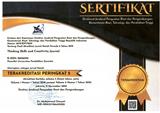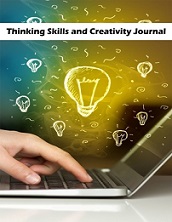Perceived and Observed Teaching Creativity in Distance Learning Activity in SMA Negeri 1 Bebandem
DOI:
https://doi.org/10.23887/tscj.v4i1.31929Keywords:
21st Century Learning, Creativity, Teachers' Creativity, Distance LearningAbstract
Penelitian ini bertujuan untuk mengamati bagaimana guru mempersepsikan kretivitas mereka dalam mengajar dan bagaimana mereka menerapkannya di dalam pembelajaran jarak jauh selama pandemi Covid-19. Metode campuran tertanam digunakan dalam proses pengumpulan data. Oleh karena itu, penelitian ini menggunakan dua tipe data yang berbeda yaitu, data Kuantitatif dan Kualitatif. Tetapi, penggunaan kedua jenis data tersebut tidak setara, hanya satu jenis data yang dominan, yang dalam penelitian ini data kualitatif lebih dominan daripada data kuantitatif. Penelitian ini dilaksanakan di SMA Negeri 1 Bebandem dan dua orang guru Bahasa Inggris dipilih sebakai subjek penelitian dalam penelitian ini. Hasil dari penelitian ini menunjukan bahwa 1) Para guru mempersepsikan bahwa mereka berada di kategori cukup kreatif dalam melaksanakan pembelajaran jarak jauh, 2) Para guru dikategorikan tidak kreatif dalam melaksanakan pembelajaran jarak jauh berdasarkan hasil observasi dan wawancara, 3) Ada perbedaan yang ditemukan antara bagaimana guru mempersepsikan kreativitas mereka dan hasil observasi guru dalam menerapkan kreatifitas mereka dalam pembelajaran jarak jauh yang mana para guru mempersepsikan bahwa mereka cukup kreatif, sedangkan hasil observasi dan wawancara menunjukan bahwa mereka berada di kategori tidak kreatif.
References
Aktaş, M. C. 2016. Turkish High School Teachers’ Conceptions of Creativity in Mathematics. Journal of Education and Training Studies , 4(2). DOI: https://doi.org/10.11114/jets.v4i2.1123
Al-Dababneh, K. A., & Al-Zboon, E. K. 2017. Can Teachers’ Self-Reported Characteristics and Beliefs about Creativity Predict their Perception of their Creativity Practices in the Classroom. International Journal Of Special Education, 723.
Arifani, Y., & Suryanti, S. 2019. The Influence of Male and Female ESP Teachers’ Creativity toward Learners’ Involvement . International Journal of Instruction, 237-238. DOI: https://doi.org/10.29333/iji.2019.12116a
Barak, M. 2006. Teaching methods for systematic inventive problem-solving: Evaluation of a course for teachers. Research in Science and Technological Education, 24 (2), 237–254. DOI: https://doi.org/10.1080/02635140600811668
Bedir, H. 2019. Pre-service ELT teachers’ beliefs and perceptions on 21st century learning and innovation skills (4Cs). Journal Of Language And Linguistic Studies , 231. DOI: https://doi.org/10.17263/jlls.547718
Boden, M. A. 1998. Creativity and artificial intelligence. Artificial Intelligence Journal, 348-349.
Boholano,H.B.2017.Smart Social Networking: 21st Century Teaching And Learning Skills. Research in Pedagogy, 21. Journal Of Language And Linguistic Studies , 312. DOI: https://doi.org/10.17810/2015.45
Bustami, S. 2011. Practical Theories of English Language Teaching and Learning.Yogyakarta, Debut Press.
Creswell, J. W. 2003. Research design: Qualitative, quantitative, and mixed methods research. Thousand Oaks, CA: Sage.
Erdem, A. R., & Adiguzel, D. C. 2019. The Opinions of Primary School Teachers on their Creative Thinking Skills. Eurasian Journal of Educational Research, 25-38. DOI: https://doi.org/10.14689/ejer.2019.80.2
Ferrari, A., Cachia, R., & Punie, Y. 2009. Innovation and Creativity in Education and Training in the EU Member States: Fostering Creative Learning and Supporting Innovative Teaching. European Commission Joint Research Center Institute for Prospective Technological Studies.
Goradia, T. 2018. Role of Educational Technologies Utilizing the TPACK Framework and 21st Century Pedagogies: Academics’ Perspectives. IAFOR Journal of Education, 45. DOI: https://doi.org/10.22492/ije.6.3.03
Goyal, S. 2012. E-Learning: Future of Education. Journal of Education and Learning, 240. DOI: https://doi.org/10.11591/edulearn.v6i4.168
Henriksen, D., Henderson, M., Creely, E., Ceretkova, S., Černochová, M., Sendova, E., . . . Al, e. 2018. Creativity and Technology in Education: An International Perspective. Technology, Knowledge and Learning . DOI: https://doi.org/10.1007/s10758-018-9380-1
Jacobs, G. M., & lengtoh-Hen, H. 2013. Small stepstowards Student-Centred Learning. JCU Singapore: P. Mandal (ed.). DOI: https://doi.org/10.1007/978-981-4560-61-0_7
Keh, L. K., Ismail, Z., & Yusof, Y. M. 2017. Creativity among Geomatical Engineering Students. International Education Studies, 44. DOI: https://doi.org/10.5539/ies.v10n4p43
Kasmaienezhadfard, S., Talebloo, B., Roustae, R., & Pourrajab, M. 2015. Students’ Learning Through Teaching Creativity: Teachers’ Perception. Journal of Educational, Health and Community Psychology , 2.
Kumar, S. S., Kumar, R. S., & Sankar, G. 2016. Creative Thinking of English Language Teaching to the Secondary Language Learners. International Journal of Linguistics, Literature and Culture , 151.
LLC, E. 2014. E-learning concepts, trends, applications. San Fransisco: Epignosis LLC.
Muianga, X., Klomsri, T., Tedre, M., & Mutimucuio, I. 2018. From Teacher-Oriented to Student-Centred Learning: Developing an ICT-Supported Learning Approach at the Eduardo Mondlane University, Mozambique. The Turkish Online Journal of Educational Technology, 47.
Nir-Gal, O. 2002. Distance learning: The role of the teacher in a virtual learning environment. Ma’of u-Ma’aseh, 8, 23-50.
Parsa, I. M. 2017. Evaluation Study Effect of Allowances and Job Creativity—The Performance of the Teacher in Secondary Vocational School Province of East Nusa Tenggara. International Education Studies, 99. DOI: https://doi.org/10.5539/ies.v10n8p96
Setiawan, R. 2017. The Influence of Income, Experience, and Academic Qualification on the Early Childhood Education Teachers’ Creativity in Semarang, Indonesi. International Journal of Instruction , 41. DOI: https://doi.org/10.12973/iji.2017.1043a
Takhyneh, B. A. 2018. Attitudes towards Using Mobile Applications in Teaching Mathematics in Open Learning Systems. International Journal of E-Learning & Distance Education La Revue Internationale De L'apprentissage à Distance, 33(2292-8588), 1-16.
Vasudevan, H. 2013. The Influence of Teachers’ Creativity, Attitude and Commitment on Students’ Proficiency of the English Language. Journal of Research & Method in Education , 12. DOI: https://doi.org/10.9790/7388-0121219
Yalcinalp, S., & Avcı, Ü. 2019. Creativity and Emerging Digital Educational Technologies: A Systematic Review . The Turkish Online Journal of Educational Technology , 25.
Ypsilandis, G. 2010. Feedback in Distance Education. Computer Assisted Language Learning. April 2002. 167-181. 10.1076/call.15.2.167.8191. DOI: https://doi.org/10.1076/call.15.2.167.8191
Zain, I. M. 2017. The Collaborative Instructional Design System (CIDS): Visualizing the 21st Century Learning . Universal Journal of Educational Research , 2259 DOI: https://doi.org/10.13189/ujer.2017.051216









